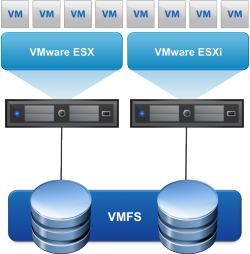Jim Hannan (@HoBHannan), Principal Architect
This blog post focuses on VMFS-5 enhancements in vSphere and how they improve Virtual Business Critical Applications (VBCA) performance and scalability. VMFS-5 offers several improvements from the previous version VMFS-3.
How VMFS-5 has improved in scalability and performance:
Newly created VMFS-5 datastores use a single unified block size of 1MB. There is no more choosing between 2MB – 8MB during VMFS creation. Standard block size of 1MB allows for improved performance, but more on this later.
VMFS-5 uses GUID Partition Table (GPT) rather than MBR, which allows for pass-through RDM (RDM-P or RDM Physical) files up to 60TB. RDM-V has a maximum size limit of 2TB.
VMFS-5 does not use SCSI-2 reservations, but uses the Atomic Test and Set (ATS) VAAI primitives. SCSI-2 reservations and ATS are used when, among other things, a lock is needed. A lock is required to perform some operations, like creating a VMDK or creating and deleting snapshots. The ATS mechanism allows for locks that are more efficient and improved performance. ATS requires the VMFS-5 files system and VAAI enabled SAN.
VMFS-5 uses SCSI_READ16 and SCSI_WRITE16 cmds for I/O (VMFS-3 used SCSI_READ10 and SCSI_WRITE10 cmds for I/O). Of the new features, this is the technology improvement I am least familiar with. My understanding of SCSI_READ10 vs. SCSI_READ16 is that SCSI_READ16 offers larger storage capacity. SCSI_READ16 uses a 64-bit Logical Block Addressing (LBA) field allowing it addressing eight Petabytes of storage. Obviously, a VMFS datastore cannot grow this large, but you can see the potential.
Upgrading to VMFS-5
HoB recommends creating new VMFS-5 datastores rather than in place upgrades of VMFS-3 to VMFS-5. When upgrading a VMFS volume you only partially benefit from some of the new features. As an example, VMFS-3 volumes upgraded to VMFS-5 will retain the original block size instead of the new 1MB block size. This affects features like Storage vMotion and ATS. In the case of ATS, the ESX hypervisor will revert to the slower SCSI-2 reservation. With Storage vMotion, a slower datamover mechanism called fs3dm will be used instead of the faster fs3dm-hw. In my next blog, Part 3 – Storage vMotion enhancements for VBCA, I will address Storage vMotion and its datamovers (fsdm, fs3dm, and fs3dm-hw).
Reference: vSphere 5 FAQ: VMFS-5







